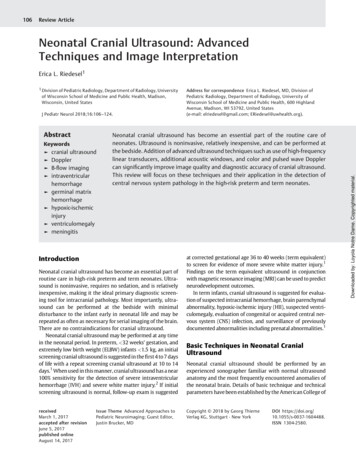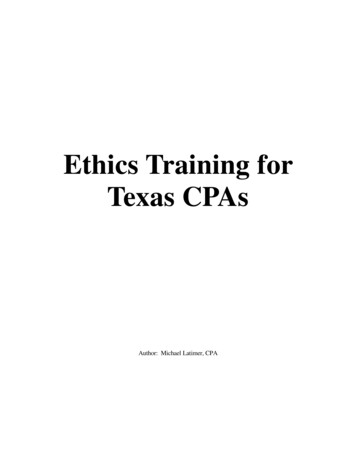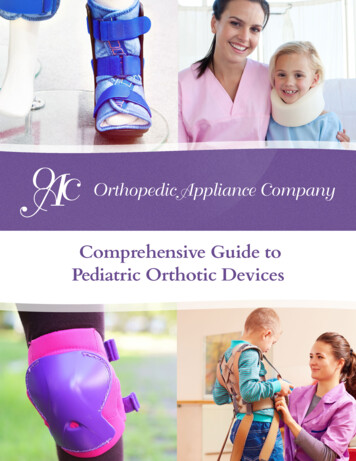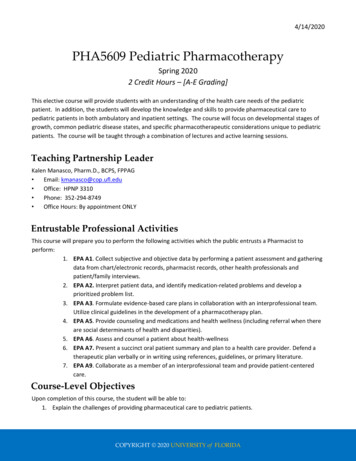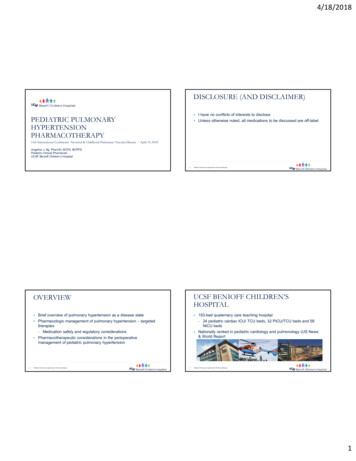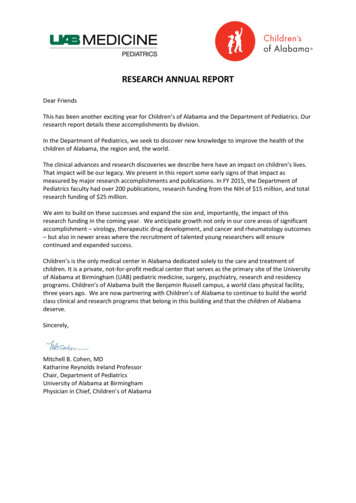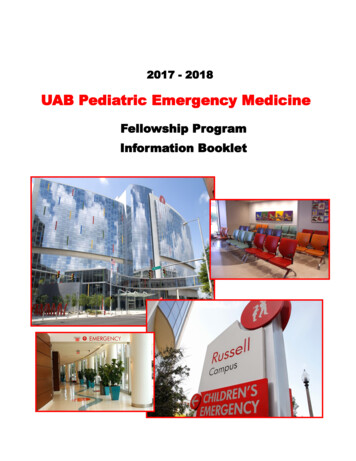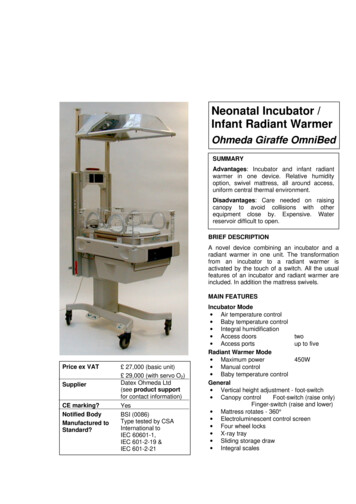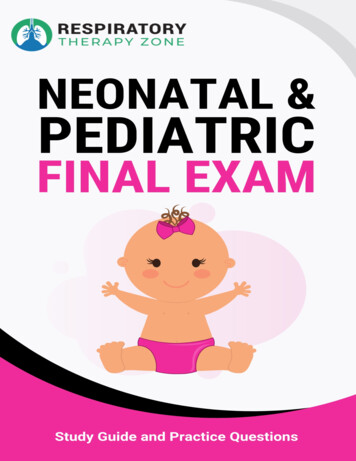
Transcription
Disclaimer:Medicine and respiratory therapy are continuously changingpractices. The author and publisher have reviewed all informationin this report with resources believed to be reliable and accurateand have made every effort to provide information that is up todate with the best practices at the time of publication. Despite ourbest efforts we cannot disregard the possibility of human errorand continual changes in best practices the author, publisher, andany other party involved in the production of this work canwarrant that the information contained herein is complete or fullyaccurate. The author, publisher, and all other parties involved inthis work disclaim all responsibility from any errors containedwithin this work and from the results from the use of thisinformation. Readers are encouraged to check all information inthis book with institutional guidelines, other sources, and up todate information. Respiratory Therapy Zone is not affiliated withthe NBRC, AARC, or any other group at the time of thispublication.You can get access to our massive bank of TMC Practice Questionsby Clicking Here. JCopyright Respiratory Therapy Zone
IntroductionWhy hello there!Thank you so much for downloading this study guide! In this book,you will find a ton of helpful practice questions, all, of course,covering the topic of — Neonatal and Pediatric Respiratory Care.These questions are designed to help you prepare for theNeo/Peds final exam in Respiratory Therapy School.Hopefully, by going through these practice questions, you will beable to boost your knowledge to a whole new level and ace yourfinal exam.This is definitely one of the most important subjects in RespiratoryTherapy School. Not to mention, it’s also the topic that somestudents struggle with.With that being said, (hopefully) this study guide, along with theresources on our website and YouTube channel can help.So if you’re ready, let’s go ahead and get started.Good luck! J
1. Which of the following statements describe truncus arteriosus?A. The pulmonary artery arises from the left ventricle, and theaorta stems from the right ventricle.B. A large VSD allows total mixing of blood from the twoventricles.C. If SVR decreases relative to PVR, blood flow will be shuntedfrom right to left, bypassing the lungs.D. All of the above2. What factor is responsible for closure of the foramen ovale?A. Increased PaO2B. Increased pressure on the left side of the heartC. Blood flowing through the lungsD. High pulmonary vascular resistance3. What is the incidence of respiratory distress syndrome (RDS)among infants born at less than 28 weeks of gestation?A. 30% to 40%B. 40% to 50%C. 60% to 80%D. 80%4. What radiographic features is the therapist likely to see on atypical chest X-ray of an infant with MAS?A. Ground-glass appearanceB. Complete whiteoutC. Decreased lung volumeD. Patchy areas of atelectasis5. The therapist is treating a child with TOF who appears to behaving a “tet” spell. What should the therapist suggest to treatthis event?A. Beta blockersB. Knee-chest position to increase SVRC. Morphine sulfateD. All of the above
6. The therapist is setting pulse oximetry to determine thepresence of right-to-left shunt in an infant suspected of havinga heart defect. Where should the therapist place the pulse oxprobe to obtain the most accurate measure of preductaloxygen saturation?A. Any finger of the right handB. Any finger of the left handC. Left earlobeD. Lower extremities7. Which of the following physiologic mechanisms need to be inplace to ensure adequate systemic perfusion in infants withhypoplastic left heart syndrome (HLHS)?A. Presence of an ASDB. Presence of a mitral regurgitationC. Adequate left atrial functionD. Presence of a PDA8. Blood samples are simultaneously obtained from both the rightradial artery and the umbilical artery, and the arterial partialpressure of oxygen (PaO2) value from the right radial artery is20 mm Hg greater than that analyzed from the umbilical arterysample. On the basis of this finding, which of the followingconditions does the neonate likely have?A. PPHNB. MASC. Neonatal pneumoniaD. RDS9. What ventilator settings should a therapist select for a newbornwith respiratory distress syndrome?A. PIP 25-30 cm H2OB. PEEP 3-6 cm H2OC. VT 5-6 mL/kgD. Frequency 60 breaths per minute
10. Why does meconium staining occur predominantly in infantsolder than 36 weeks of gestational age?A. Because these infants can generate strong inspiratoryeffortsB. Because infants this age have significant cardiac outputsC. Because these infants demonstrate strong peristalsisD. Because these newborns have weak anal sphincter tone11. Which of the following clinical manifestations is consistent withan atrial septal defect (ASD)?A. An ASD often causes congestive heart failure (because ofdecreased pulmonary blood flow).B. The right ventricle may become hypertrophic (rightventricular hypertrophy).C. Most patients with an ASD are symptomatic in the neonatalintensive care unit, presenting with right atrial enlargement.D. Chest radiographs are usually abnormal.12. What is the typical type of airway obstruction that occurs withMAS?A. Ball valveB. CompleteC. No obstructionD. Airway inflammation13. How should the therapist interpret a preductal-to-postductalPaO2 difference of 8 mm Hg in a neonate?A. Unreliable dataB. Absence of ductal shuntingC. Presence of ductal shuntingD. Inconclusive data14. Which of the following congenital cardiac anomalies isclassified as conotruncal, associated with a “boot-shaped”appearance of the heart?A. Tetralogy of FallotB. Transposition of the great vessels
C. Coarctation of the aortaD. Atrioventricular canal defect15. Which of the following medications should the therapistrecommend for an infant with apnea of prematurityexperiencing episodes of apnea?A. CaffeineB. BenzodiazepinesC. AntibioticsD. Doxapram16. Which of the following therapeutic interventions is generallyneeded to treat transient tachypnea of the newborn (TTN)?A. Endotracheal intubationB. 30%-40% oxygen hoodC. Bronchial hygiene therapyD. Bronchodilator therapy17. Which of the following blood gas parameters should thetherapist target when managing patients with PPHN?A. SaO2 95%B. PaCO2 35-45 mm HgC. pH 7.35-7.45D. All of the above18. Eight hours after being born, a baby presents with cyanosisdespite administration of adequate ventilation, tachypnea, andretractions. Which of the following conditions should thetherapist suspect is affecting this newborn?A. RDSB. BPDC. PPHND. GBS pneumonia19. Which of the following clinical features characterize a criticalaortic stenosis in a neonate?
A. Chest radiography reveals pleural effusion and pulmonaryengorgement.B. The neonate often has metabolic alkalosis.C. The neonate presents in cardiogenic shock withhypotension.D. These infants are rarely symptomatic during the firstmonth of life.20. When using sub-ambient oxygen therapy, what range ofoxygen saturations should the therapist target?A. 95% to 95%B. 85% to 90%C. 75% to 85%D. 70% to 80%21. At birth, what factor causes dilation of the pulmonary vascularbed and a decrease in the pulmonary vascular resistance?A. Increased arterial partial pressure of oxygen (PaO2)B. Decreased arterial partial pressure of carbon dioxide(PaCO2)C. Lung inflationD. Circulating indomethacin22. While reviewing the chest X-ray of a newborn, the therapistobserves the following features:I. Pulmonary vascular congestionII. Prominent perihilar streakingIII. Fluid in the interlobular fissuresIV. HyperexpansionV. Flat diaphragmWhich of the following conditions does this patient likelyhave?A. RDSB. Persistent pulmonary hypertension of the newbornC. Transient tachypnea of the newbornD. Barotrauma
23. While reviewing the chest X-ray of a newborn, the therapistobserves the following features: continuous diaphragm signand linear bands of air paralleling the left side of the heart andthe descending aorta with extension superiorly along thegreat vessels into the neck. Which of the following conditionsdoes this patient likely have?A. PneumothoraxB. Cardiac tamponadeC. PneumomediastinumD. Pneumopericardium24. How should the therapist interpret a lecithin-tosphingomyelin (L:S) ratio of 2:1?A. The presence of lung maturityB. A gestational age of less than 28 weeksC. The likelihood of RDSD. Laboratory error25. The therapist is treating a child with a congenital heart defectwho is unresponsive to oxygen therapy. Although the chest Xray is relatively normal, the heart is described as “egg-shaped.”Which of the following heart defects is more consistent withthis description?A. Complete transposition of the great arteriesB. Coarctation of the aortaC. Truncus arteriosusD. Tetralogy of Fallot26. Which of the following strategies can be used to increasepulmonary vascular resistance (PVR) in infants withhypoplastic left heart syndrome (HLHS)?A. FiO2 0.21B. Induce hypocapniaC. Administer indomethacinD. Close the PDA
27. Which of the following methods is involved in themanagement of a PDA?A. Increasing the circulating volumeB. Maintaining/optimizing the hematocrit at the low end ofnormal hemoglobin levelC. Administering indomethacinD. Administering digoxin28. For which of the following congenital cardiac defects mayspontaneous closure of the ductus arteriosus be catastrophic?A. Tetralogy of Fallot with pulmonary atresiaB. Hypoplastic left heart syndromeC. Severe coarctation of the aortaD. All of the above29. The therapist is reviewing the chest radiograph of a newborn,preterm infant and observes diffuse, fine, reticulogranulardensities, which provide a ground-glass appearance. On thebasis of these radiographic findings, which of the followingconditions should the therapist suspect is present?A. Persistent pulmonary hypertension of the newbornB. Respiratory distress syndromeC. Bronchopulmonary dysplasiaD. Pulmonary interstitial emphysema30. In addition to Group B Streptococcus, which of the followingmicroorganisms are responsible for nosocomial pneumoniaacquired after delivery?A. RSVB. Escherichia coliC. Pseudomona spp.D. Haemophilus influenza31. Which of the following risk factors contribute to thepathogenesis of BPD?A. Lung immaturityB. Respiratory failure
C. Oxygen supplementationD. All of the above32. What is the significance of an infant with RDS demonstratinga grunt during each exhalation?A. Resolution of the RDSB. An effort to maintain its functional residual capacity (FRC)C. An attempt to overcome increased airway resistanceD. Impending death33. The therapist is assessing a newborn on the mechanicalventilator. The neonate shows clear signs of respiratorydistress, and lung auscultation reveals shifting of the PMItowards the left and breath sounds decreased on the right.What should the therapist suspect this newborn developed?A. Right-sided pneumothoraxB. Severe right lung atelectasisC. Right pleural effusionD. Left-sided atelectasis34. When neonatal pneumonia is suspected, how long does aninfant generally receive broad-spectrum antibiotics?A. 24 hoursB. 48 hoursC. 72 hoursD. 96 hours35. Identify the following congenital cardiac anomaly:A. Truncus arteriosusB. Hypoplastic left ventricleC. Transposition of the great vesselsD. Ventricular septal defect36. Which of the following medications is the most commonpreoperative treatment to minimize preductal constrictionuntil surgical correction of coarctation of the aorta can beachieved?
A. IndomethacinB. Prostaglandin E1C. Negative inotropesD. Diuretics37. When should a therapist consider intubation and mechanicalventilation for a newborn with respiratory distress?A. FiO2 40% to 70%B. SpO2 85%C. CPAP of 5-10 cm H2OD. All of the above38. When should a therapist consider CPAP for a newborn withrespiratory distress?A. FiO2 40% to 70% and SpO2 85%B. FiO2 90% and SpO2 95%C. Respiratory rate of 40 breaths per minuteD. PaO2 50 to 60 mm Hg39. A therapist monitoring an infant after a Blalock-Tausig shuntplacement notices a significant drop in the end-tidal carbondioxide (ETCO2) despite no changes in the infant’s respiratoryrate. How should the therapist interpret this change?A. The infant has dramatically improved ventilation bybreathing deeply.B. The ETCO2 monitor is not accurate.C. Loss of pulmonary blood flow through the shuntD. Tricuspid regurgitation40. Which of the following blood flow patterns occurs in completetransposition of the great arteries?A. The systemic venous blood passes through the right heartchambers.B. The pulmonary venous blood traverses the left side of theheart and then returns to the systemic circulation.C. When PVR increases relative to SVR, blood flow increasesthrough the ductus arteriosus.
D. Systemic venous blood flows to the lungs after leaving theright ventricle.41. Which of the following clinical pathophysiologicmanifestations are consistent with a large ventricular septaldefect (VSD)?A. The majority of the blood flow is shunted from left right toright left.B. Shunting typically occurs during ventricular diastole, whichcauses left atrial enlargement.C. Chest radiography reveals a decreased cardiac silhouetteand decreased pulmonary vascular markings, decreasingpulmonary blood flow.D. Thickening and fibrosis of the pulmonary veins develop,decreasing pulmonary artery pressure.42. A newborn suspected of having a pneumothorax is rapidlydeteriorating. What should the therapist suggest at this time?A. Intubation and mechanical ventilationB. Mask CPAPC. Needle aspirationD. Confirm air leak with a chest X-ray and place a chest tubeafterwards43. What should the therapist select as target gas exchangeparameters after surgical intervention for infants withhypoplastic left ventricular syndrome HLHS?A. pH 7.35B. PaO2 of 60 mm Hg and PaCO2 of 60 mm HgC. pH 7.45D. PaO2 of 40 mm Hg and PaCO2 of 40 mm Hg44. How should the therapist interpret the lack of foam appearingduring the shake test?A. The test needs to be redoneB. The unborn infant’s lungs have maturedC. The infant’s lungs are immature
D. The patient has a 50% chance of developing RDS45. Which of the following vessels return blood to the rightatrium?A. Coronary sinusB. Inferior vena cavaC. Superior vena cavaD. All of the above46. Which of the following conditions increase the risk fordeveloping RDS?A. Maternal diabetesB. Cesarean deliveryC. Multiple birthsD. All of the above47. Identify the congenital cardiac defect depicted in thefollowing illustration:A. Atrial septal defectB. Hypoplastic left ventricular syndromeC. Hypoplastic right ventricular syndromeD. Atrioventricular canal defect48. Why must supplemental oxygen be judiciously administeredto patients with an atrioventricular canal defect?A. To prevent the development of retinopathy of prematurityB. To avoid oxygen-induced hypoventilationC. To minimize pulmonary vascular dilationD. To reduce oxidative stress49. The therapist is contemplating the possibility of intubatingand suctioning a non-vigorous newborn with MAS. Which ofthe following clinical parameters confirms the indication forthe procedure?A. Good muscle toneB. Presence of dark green meconium on the skinC. Heart rate 100 beats per minute
D. Presence of coarse crackles on auscultation50. A neonate diagnosed with a pneumothorax was treated witha chest tube. After 36 hours, the therapist noticed thatbubbling is present in the chest tube system. What should thetherapist do at this time?A. Suggest removal of the chest tube in 24 hoursB. Clamp the tube and obtain a CXRC. Keep the chest tube until bubbling stopsD. Remove the chest tube and obtain a follow-up CXR51. A therapist is monitoring a child on the mechanical ventilatorwho is hemodynamically stable. The PetCO2 is 48 mm Hg. Ifaccurate, what should be the PaCO2?A. 43-48 mm HgB. 45-48 mm HgC. 50-53 mm HgD. None of the above52. What is volumetric capnography able to determine?I. Airway dead spaceII. Alveolar tidal volumeIII. Shunt fractionIV. Alveolar minute volumeA. II, III, and IV onlyB. I onlyC. I, II, and IV onlyD. I, II, III, and IV53. The respiratory therapist has initiated iNO at 20 ppm for aninfant with pulmonary hypertension. After 2 hours a blood gastest reveals a 10% improvement in SaO2. What should thetherapist do?A. Keep iNO at 20 ppm and wait at least 2 hours beforeconsidering any change.B. Increase iNO to 30 ppm and keep the same FiO2.C. Keep iNO at 20 ppm and wean the FiO2 by 10%.
D. Increase iNO to 30 ppm with no changes in FiO2.54. Vascular smooth muscle is largely dependent on which of thefollowing intracellular ions?A. Na B. K C. Ca2 D. Mg2 55. Which of the following medications contributes to anincreased right-to-left intrapulmonary shunting?A. DobutamineB. DopamineC. ProstacyclinD. Prostaglandin A56. The therapist is performing a routine assessment andventilator check on a patient who is receiving heliox near thewye adapter of the ventilator circuit. He notices a seriousdiscrepancy between the set tidal and the exhaled volume.What should the therapist do to correct this situation?A. Administer heliox through the heliox-approved inlet of themechanical ventilatorB. Add a 16-inch piece of corrugated tubing between the wyeadapter and the place on the inspiratory limb where heliox isadministeredC. Reduce the liter flow on the helioxD. Adjust ventilator settings to compensate for the lowerviscosity of heliox57. The therapist taking care of an infant on iNO observes that theNO2 levels have been increasing. In order to correct thesituation, he increases the inspiratory flow of the ventilator.What will be some of the limitations associated with thischange?I. It reduces time of contact between NO and O2.
II. It affects the mean airway pressure because it changes theinspiratory time.III. It may increase the delivered tidal volume.IV. It reduces the mean airway pressure and increases theinspiratory time.A. I onlyB. II and IV onlyC. I, II, and III onlyD. II, III, and IV only58. Which of the following features or characteristics apply tomainstream capnography?I. The mainstream capnograph contains narrow tubing thatcan become occluded with mucus.II. Mainstream capnography generally employs infraredspectrometers.III. The mainstream capnograph does not add much weightto the breathing circuit.IV. The mainstream capnograph is placed at the proximalend of the endotracheal tube.A. I and II onlyB. II and IV onlyC. I, II, and III onlyD. I, III, and IV only59. During the administration of aerosol therapy, how does aheliox mixture compare with an air–oxygen mixture as acarrier gas?A. Less aerosol is deposited with heliox.B. More aerosol is deposited with heliox.C. The two gas mixtures are equally efficient.D. Definitive data are not available.60. An infant on high-flow nasal cannula also requiresadministration of albuterol every 6 hours. The flow of thecannula was adjusted from 4 to 5 liters per minute. How couldthis affect the aerosol delivery to this infant?
A. It will be unchanged.B. It will decrease.C. It will increase.D. None of the above61. Which of the following parameters of mechanical ventilationare affected negatively by the use of heliox?A. PEEPB. Plateau pressureC. Peak pressureD. Volume62. What is the purpose of administering helium–oxygen gasmixtures to patients?A. To reduce the work of breathingB. To improve gas exchangeC. To increase the functional residual capacityD. To improve pulmonary compliance63. What is the normal gradient between PaCO2 and end-tidalCO2 (PaCO2 minus end-tidal CO2)?A. -2 to -5 mm HgB. 2 to 5 mm HgC. -5 to -10 mm HgD. 5 to 10 mm Hg64. What is the primary physiologic activity of inhaled nitricoxide?A. BronchodilationB. Pulmonary vasodilationC. Systemic vasodilationD. Cerebral vasodilation65. What clinical parameter is critically important to monitorwhen mechanical ventilation is administered?A. Blood pressureB. Heart rate
C. TemperatureD. Respiratory rate66. The therapist is treating a very irritable young child with upperairway obstruction. Which oxygen device will be the mostappropriate to administer the greatest concentration ofhelium?A. Close-fitting nonrebreathing maskB. Close-fitting partial rebreathing maskC. Nasal cannulaD. High flow nasal cannula67. Why do transcutaneous oxygen tension (PO2) and carbondioxide tension (PCO2) values differ from PaO2 and PaCO2measurements?A. Because of the lag time between the cardiac output andthe time the blood reaches the transcutaneous electrode siteB. Because the skin is much more permeable to oxygen thancarbon dioxideC. Because oxygen is consumed and carbon dioxide isproduced in transit from the left ventricle to the electrodesiteD. Because metabolism in the tissue consumes oxygen andproduces carbon dioxide at the site of the electrode68. As the therapist applies a pulse oximeter finger probe to aneonate who is receiving supplemental oxygen, she noticesthat the SpO2 reading is 100%. What should the therapist do inthis situation?A. The therapist should continue monitoring the patientbecause the reading is accurate.B. The therapist should obtain an arterial blood sample toconfirm PaO2 level.C. The therapist should switch to using a capnometer.D. The therapist should reduce the fraction of inspiredoxygen.
69. Inhaled NO has been administered to an infant for nearly 4hours. The respiratory therapist notices suboptimal responseand suggests HFOV. What is the principle behind thepotential benefit of adding this ventilatory modality to thisinfant?A. HFOV improves ventilation and reduces the formation ofNO2.B. Lung volumes are optimized with HFOV and furtherenhance the effects of iNO.C. The high frequency accelerates the diffusion of NOthrough the alveolar surface.D. HFOV reduces the need for higher doses of iNO.70. An infant has been receiving iNO for the last 3 days. Whichimportant level should be monitored when ordering a cooximetry?A. MethemoglobinB. CarboxyhemoglobinC. Reduced hemoglobinD. Oxyhemoglobin71. How is the percentage of functional hemoglobin that issaturated with oxygen determined via pulse oximetry?A. The percentage of red light that lands on the photodioderepresents the SpO2 (oxygen saturation as determined bypulse oximetry).B. The percentage of infrared light that reaches thephotodetector reflects the SpO2.C. The ratio of the red and infrared light that reaches thephotodiode signifies the SpO2.D. None of the above72. Which of the following conditions will preclude the use ofindirect calorimetry?I. Cuffed endotracheal tubesII. Circuit leaksIII. FiO2 40%
IV. HFOVA. I, II, and III onlyB. II and III onlyC. II and IV onlyD. I, III, and IV only73. The therapist has applied a bandage-type pulse oximetryprobe too tightly to an infant’s finger. What problem can beexpected to occur in this situation?A. The SpO2 will read erroneously low.B. The SpO2 will read erroneously high.C. The monitor will display a message indicating inadequatepulse.D. The monitor will display fluctuating SpO2 values betweenbeing erroneously low and high.74. Which of the following is the main physiologic factorresponsible for deriving accurate transcutaneous data?A. Heart rateB. Minute ventilationC. Peripheral perfusionD. Ventilation-perfusion ratios75. Which of the following substances prevents the release ofCa2 from the sarcoplasmic reticulum?A. Intracellular cGMPB. EDRFC. cGMP-dependent kinaseD. Calmodulin76. Which of the following inhaled anesthetic gases has/havedemonstrated the possibility to treat status asthmaticus?I. HalothaneII. ThromboxaneIII. IsofluraneIV. SevofluraneA. II only
B. I, II, and III onlyC. I, III, and IV onlyD. II, III, and IV only77. What is the potential benefit of adding heliox to patients whohave status asthmaticus while undergoing mechanicalventilation?A. To improve pulmonary complianceB. To reverse bronchospasmC. To minimize air trappingD. To facilitate the removal of tracheobronchial secretions78. While attending to a neonatal patient in the neonatalintensive care unit (NICU), the therapist notices that atranscutaneous electrode is affixed to the upper chest of theneonate. What should the therapist do at this time?A. The therapist should only continue monitoring the patientsince the transcutaneous electrode is properly placed.B. The therapist should reposition the electrode on theneonate’s abdomen.C. The therapist needs to move the transcutaneous electrodeto the infant’s right shoulder.D. The therapist should relocate the electrode on thesternum as close as possible to the heart.79. The therapist is evaluating a small tachypneic infant receivingheliox mixture 70:30 through an infant hood. Although theSpO2 has improved, the child shows signs of worsening workof breathing. What is the most probable mechanism toexplain this situation?A. The FiHe is too low in a 70:30 mixture to change work ofbreathing in this infant.B. The flow going through the infant hood is inadequate.C. A greater concentration of helium is present at the top ofthe hood and away from the infant’s nose and mouth.D. The infant is breathing too fast; thus heliox is not reachingthe airways.
80. Although very small amounts of NO2 are present at thebedside, which health care workers need to exert specialprecautions to minimize exposure to NO2?A. Nurses in the NICUB. Air transport team membersC. Ground transport team membersD. Respiratory therapists in the NICU81. What is the purpose of indirect calorimetry?A. To measure heat produced and lost from the bodyB. To calculate energy expenditure by measuring VO2 andVCO2C. To calculate resting energy expenditureD. To measure gas exchange82. A patient who has been admitted with status asthmaticus isreceiving beta adrenergics every 2 hours and heliox with verylimited response. What should the therapist suggest at thistime?A. Change heliox to 100% heliumB. Administer nitrogenC. Administer inhaled anestheticsD. Add iNO83. Which of the following inhaled anesthetics should thetherapist recommend to administer via a face mask to aconscious, spontaneously breathing pediatric patient who hasstatus asthmaticus?A. IsofluraneB. EnfluraneC. SevofluraneD. Halothane84. What is the product of the reaction between oxygen and nitricoxide?A. Oxygen radicals
B. N2OC. NO2D. The two molecules do not react with each other.85. The therapist is using an oxygen flowmeter to deliver an 80:20heliox mixture to a patient. The reading on the flowmeter is 10L/minute. What is the actual flow received by the patient?A. 5.5 L/minuteB. 10 L/minuteC. 12.5 L/minuteD. 18 L/minute86. The therapist has been asked to measure preductal oxygensaturation. Where could the therapist place the pulseoximeter probe?A. Right thumbB. Left thumbC. ForeheadD. Left earlobe87. After increasing the inspiratory flow of the ventilator todecrease the generation of NO2 the therapist notices manychanges in the ventilator parameters. The therapist adds theNO into the inspiratory limb of the ventilator circuit close tothe patient. What will be a limitation of the procedure?A. A larger number of oxygen radicals are produced at thisposition.B. Adding NO too close to the patient reduces proper mixing,which is necessary to ensure accurate NO measurement.C. Adding NO in this position of the circuit is contraindicated.D. The contact time between NO and O2 is too long to beclinically useful.88. The respiratory therapist has initiated nitric oxide for an infantwith severe refractory hypoxemia. The initial dose was 20 ppmand titrated up to 30 ppm for the last 4 hours due to lack of
response. However, there still is no response. What should thetherapist do?A. Increase iNO to 40 ppmB. Increase iNO to 60 ppmC. Increase iNO to 80 ppmD. Discontinue iNO and consider a different therapeuticintervention89. The therapist is assessing a mechanically ventilated infant andobserves that the transcutaneous electrode temperature is setbetween 41 C and 44 C. What action does the therapist needto take at this time?A. The temperature range set is appropriate; therefore, noaction is necessary.B. The therapist should increase the temperature range to47 C to 48 C.C. The temperature of the transcutaneous electrode needs tobe reduced to 36 C to 38 C.D. The electrode needs to be repositioned and maintained atthe same temperature.
ConclusionSo there you have it! Wow, you made it all the way to the end —that’s impressive!By doing so, that lets me know that you have what it takes tobecome a successful Respiratory Therapist.You’re definitely on the right track, so keep working and studyinghard and you’ll be just fine.And not to worry — we’re going to be with you every step of theway along your journey.Thanks again for reading through this study guide! If you thoughtthat these questions were helpful, you should definitely considerchecking out our TMC Test Bank.It’s a MASSIVE bank of practice questions that are designed toteach you everything you need to know in order to pass the TMCExam.It comes in PDF format (like this book) and also has helpful audioand videos as well.Not to brag or anything, but it’s already successfully helpedthousands of students pass the TMC Exam!Are you next?It’s never too early to start preparing for the exam!And going through practice questions is one of the most effectivestrategies that students are using to pass the exam.That’s why our TMC Test Bank is so effective.
So if you’re interested, just click the link below to learn more.Click Here to Get Access to the TMC Test BankBreathe easy, my friend! Johnny Lung RRT
One more thing!How would you like to get new TMC Practice Questions sent toyour inbox every single day?If this is something that sounds interesting to you, Click Here tolearn more.As I mentioned before, going through practice questions is one ofthe most effective strategies when it comes to passing the TMCExam.Well now, you can get new practice questions delivered straight toyour inbox on a daily basis.This way, over time, you can master every single topic that youneed to know to increase your chances of pass
Thank you so much for downloading this study guide! In this book, you will find a ton of helpful practice questions, all, of course, covering the topic of — Neonatal and Pediatric Respiratory Care. These questions are designed to help you prepare f
